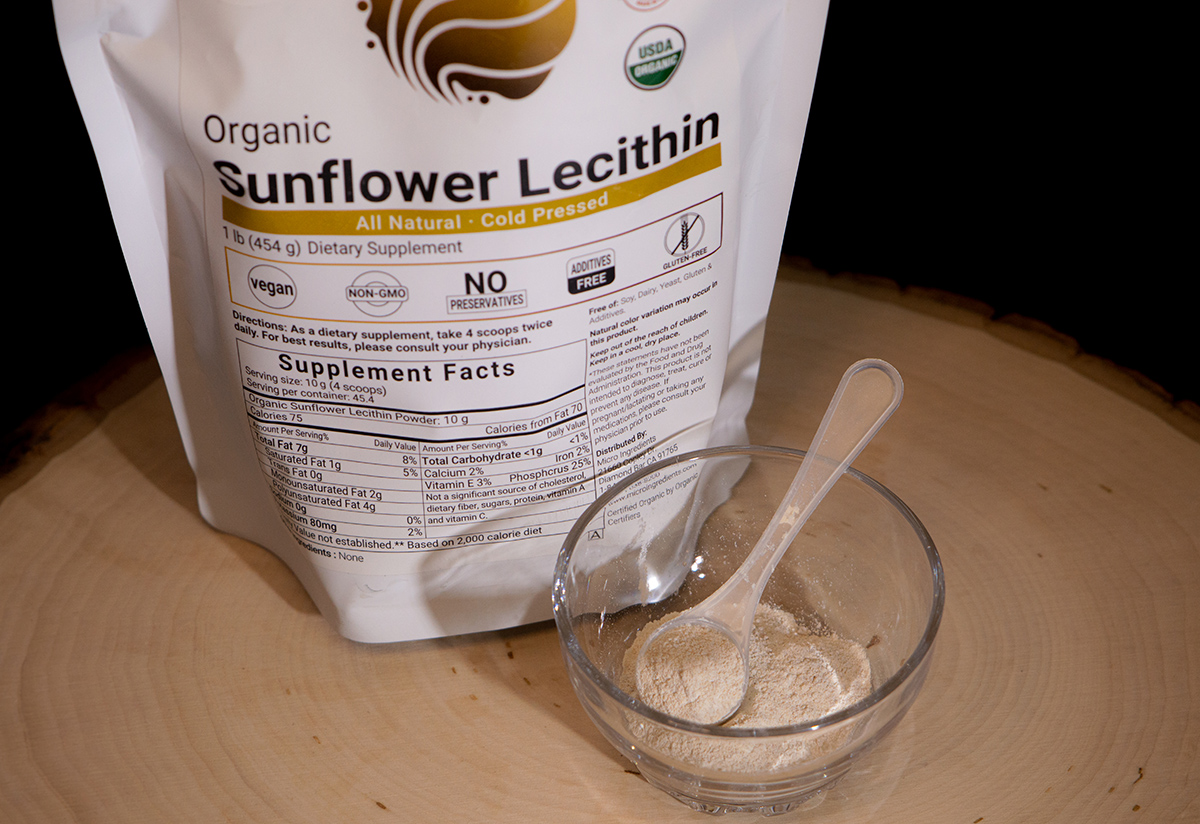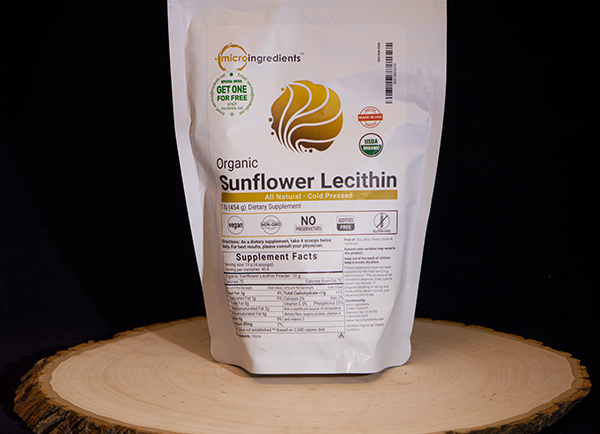
March 29, 2021 – By Angela Laufer
In cooking recipes, there is a multitude of ways to improve your dish’s flavor, texture, and presentation to make your experience fun and more memorable. This is no exception in the world of cooking cannabis edibles! Lecithin is one secret weapon that can improve the structural integrity, shelf life, and your body’s absorption of cannabinoids from your edibles.

WHAT IS LECITHIN?
Lecithin is a phospholipid, a type of fat that is often used as an additive to make sure certain ingredients bind and stick together that would usually repel each other. It works as an emulsifying agent, which means it helps foods that don’t usually mix, to mix and stay together. Lecithin is naturally existing and can be found within egg yolks (which is why eggs are frequently used in recipes to thicken sauces and bases), avocados, soybeans, sunflowers and more. By attracting both water and fatty substances, lecithin works as a binding agent, which also makes what you are eating easier to digest. Because of this, it’s easy to see why lecithin is so important and widely used in creating edibles such as gummies, chocolates, and butter, especially when they’re to be poured into molds. For example, a cake or a loaf of bread would simply crumble and fall apart without binding agents, the same way that your edibles can. You don’t want to create a beautifully made edible only for it to crumble in front of you.
WHY ADD LECITHIN TO EDIBLES?
There are multiple reasons to use lecithin when cooking up a batch of cannabis edibles. Besides the main benefit of improving their structural integrity, the presence of lecithin within your cannabis edibles can increase shelf life and avoid degradation by preventing the separation of fats and waters. This prevention of separation greatly lessens the chance of mold and mildew formation.
Perhaps one of the more popular reasons cannabis enthusiasts get excited about the use of lecithin, is the greater “potency” of their edibles -in a round-about way-. Lecithin improves the bioavailability of cannabinoids. As a result of better absorption, the body metabolizes more cannabinoids and terpenes thus increasing the effects we would already experience. Cannabis edibles, by themselves, are packed with a multitude of cannabinoids and terpenes. The increased cannabinoid absorption means that less THC and CBD is wasted by the body. And because your body may have an easier time accessing and digesting the bound ingredients, it may result in enhanced experience and higher therapeutic efficacy.
WHAT IS THE BEST SOURCE?
Although some will credit all forms of lecithin of having benefits, I have found that sunflower lecithin is most favored, even though soybean lecithin is more common and much easier to find. The reason being, is that soybean lecithin is usually extracted with harsh and potentially dangerous chemicals. Soy lecithin is also shown to be mostly genetically modified and is typically used in processed foods, pesticides, and drugs, giving lecithin a bad rap. Whereas sunflower lecithin is naturally sourced and offers a plethora of health benefits. Many regard sunflower lecithin as the most superior form. While it’s more expensive, it comes from a minimally processed source; it’s cold-pressed from the seeds and comes in a finely ground powder that’s easy to work with.
HEALTH BENEFITS
In addition to the structural benefits of your edibles, sunflower lecithin has an abundance of beneficial effects to your health. Here are just a few:
Improves Cognitive Function: Lecithin also serves as a surfactant (a compound that lowers surface tension). If you are already lecithin deficient, your cell membranes are hardened, and it’s tough to get anything through. If you are exposed to heavy metals, toxins, pollutants, plaque, etc., your cell membranes are even harder. Adding lecithin is a great way to help those membranes loosen up and increase absorption and communication between your cells.
Reduces Visceral Fat & Helps Repair Liver Damage: Visceral fat sits around your vital organs. Reducing these fats help maintain the health and efficiency of your organs. The same way that it helps remove fats, lecithin helps to remove toxins that build up inside your organs. Because the liver is basically a filter that eliminates waste, the removal of these fats and toxins and prevention of more build-up, can be incredibly beneficial for the health of your liver.
Aids in Immune System: Lecithin helps to coat our red blood cells and provide protection against the invasion of viruses and bacteria. Sunflower lecithin is also a wonderful source of phosphatidylcholine, one of the most powerful antioxidants found on earth. Antioxidants protect our bodies from dangerous molecules knows as “free radicals”, which can cause cancers and premature aging.
Reduces Cholesterol Levels: Lecithin is a solvent for cholesterol, triglycerides and gnarly fats, preventing hardening of the arteries, stroke and other heart related issues.
Improves Clarity of Skin & Hair: Because lecithin is involved in the makeup of our body’s cell membranes, it can improve the structure and clarity of our skin and hair. If you suffer from acne, psoriasis, or dry cracked hair and skin, adding lecithin to your diet may benefit you in these areas.
Here is a short and sweet video that helps list lecithin’s benefits:
HOW TO ADD LECITHIN
Now that we’ve touched on what lecithin is, how versatile an ingredient it can be and its possible health benefits, it’s time to talk about how to add it to your recipes. Adding lecithin to edibles is incredibly easy and straight forward. A good rule of thumb is to add 1t lecithin for every 1 cup of liquid (coconut oil, butter, milk, etc.). You add your 1t of lecithin to your recipe by dissolving it in your liquid ingredients, and then continue to make the recipe in every way as you normally would.
It is possible that the consistency may not be just right the first time. If the texture is lacking, add a bit more lecithin in the next batch. On the other hand, if the sunflower flavor is too noticeable, then add a little less lecithin your next go around. As always, every cannabis cook has their own way of doing things, their own “spin” and suggestions on how to create a recipe. Have fun with the process and find what works for you and your individual tastes and preferences. (:
Happy cooking!
Berg, E. DC (2020). The 11 Benefits of Lecithin [Video]. YouTube. https://www.youtube.com/watch?v=4pVEedOSXT8&t=182s
Latifi, S., Tamayol, A., Habibey, R., Sabzevari, R., Kahn, C., Geny, D., Eftekharpour, E., Annabi, N., Blau, A., Linder, M., & Arab-Tehrany, E. (2016). Natural lecithin promotes neural network complexity and activity. Scientific reports, 6, 25777. https://www.nature.com/articles/srep25777
Miranda, D. T., Batista, V. G., Grando, F. C., Paula, F. M., Felício, C. A., Rubbo, G. F., Fernandes, L. C., Curi, R., & Nishiyama, A. (2008). Soy lecithin supplementation alters macrophage phagocytosis and lymphocyte response to concanavalin A: a study in alloxan-induced diabetic rats. Cell biochemistry and function, 26(8), 859–865. https://onlinelibrary.wiley.com/doi/abs/10.1002/cbf.1517
Mourad, A. M., de Carvalho Pincinato, E., Mazzola, P. G., Sabha, M., & Moriel, P. (2010). Influence of soy lecithin administration on hypercholesterolemia. Cholesterol, 2010, 824813. https://doi.org/10.1155/2010/824813
Spiers, P. A., Myers, D., Hochanadel, G. S., Lieberman, H. R., & Wurtman, R. J. (1996). Citicoline improves verbal memory in aging. Archives of neurology, 53(5), 441–448. https://doi.org/10.1001/archneur.1996.00550050071026
Stremmel W, Hanemann A, Ehehalt R, Karner M, Braun A. Phosphatidylcholine (lecithin) and the mucus layer: Evidence of therapeutic efficacy in ulcerative colitis? Dig Dis. 2010;28(3):490-6. doi: 10.1159/000320407. Epub 2010 Sep 30. PMID: 20926877.
Suetsugu S, Kurisu S, Takenawa T. Dynamic shaping of cellular membranes by phospholipids and membrane-deforming proteins. Physiol Rev. 2014 Oct;94(4):1219-48. doi: 10.1152/physrev.00040.2013. PMID: 25287863.